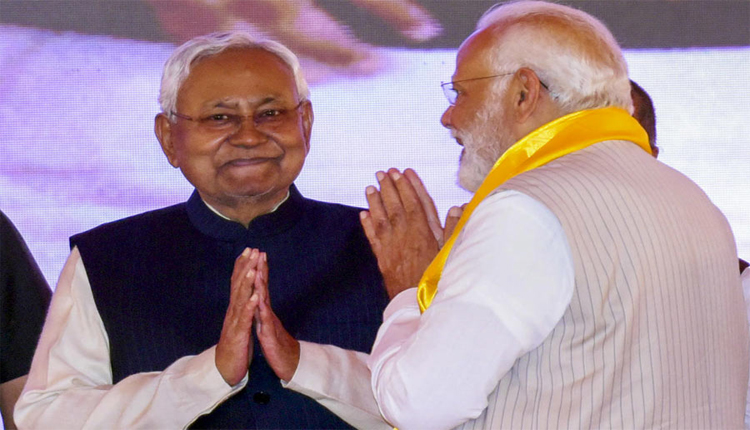Patna: As the Bharatiya Janata Party (BJP) basks in its third consecutive term at the Centre under Prime Minister Narendra Modi, its continued reliance on the Janata Dal (United) (JD(U)) in Bihar has sparked curiosity and debate.
Despite the BJP’s formidable national presence since 2014, the party remains tethered to Chief Minister Nitish Kumar’s JD(U) in Bihar, a state where caste dynamics and electoral arithmetic make alliances indispensable. With the 2025 Bihar Assembly elections looming, the BJP’s decision to maintain this partnership underscores a strategic necessity rooted in the state’s complex socio-political landscape.
The Power Of Nitish Kumar’s Social Engineering
At the heart of the BJP-JD(U) alliance lies Nitish Kumar’s unparalleled ability to mobilise Bihar’s diverse voter base, particularly the Extremely Backward Classes (EBCs) and non-Yadav Other Backward Classes (OBCs). Constituting roughly 36% and 20% of the state’s population, respectively, these communities form a critical electoral bloc. Nitish, a Kurmi leader, has cultivated a loyal following among these groups through decades of social engineering, a feat the BJP has struggled to replicate independently. “Nitish Kumar’s appeal among EBCs and non-Yadav OBCs is a game-changer. His JD(U) consistently delivers a vote share of 15–25%, making it a vital cog in the NDA’s Bihar machinery,” noted a senior BJP strategist.
The 2024 Lok Sabha elections underscored this dynamic, with JD(U) matching the BJP’s tally by securing 12 of Bihar’s 40 seats, contributing significantly to the National Democratic Alliance’s (NDA) haul of 30 seats. Despite holding nearly double the JD(U)’s seats in the 243-member Bihar Assembly (74 vs. 43 in 2020), the BJP has ceded the Chief Minister’s post to Nitish, acknowledging his broader appeal and ability to consolidate votes across caste lines.
A Fragile But Essential Alliance
The BJP-JD(U) relationship has not been without turbulence. Nitish Kumar’s political flip-flops — leaving the NDA in 2013 over Modi’s elevation, rejoining in 2017, exiting again in 2022, and returning in 2024— have earned him the moniker “Paltu Kumar”, which roughly translates into “fickle ally.” Yet, the BJP’s pragmatism prevails, recognising that Bihar’s electoral landscape is too fragmented for it to dominate alone. In 2015, when the BJP faced a JD(U)-RJD-Congress combine, it secured only 53 seats, finishing a distant third. The lesson was clear: without JD(U), the BJP risks ceding ground to the Rashtriya Janata Dal (RJD), which commands a loyal 32% vote share from Yadavs (14%) and Muslims (18%).
The BJP’s lack of a charismatic state leader further cements JD(U)’s importance. The passing of Sushil Kumar Modi, a key figure who bridged the BJP-JD(U) divide, left a leadership vacuum. Despite appointing six deputy chief ministers under Nitish, none have matched his stature or influence. “Nitish Kumar is the face of governance in Bihar. His track record of development and social welfare schemes resonates with voters, complementing Modi’s national appeal,” said political analyst Santosh Singh.
U
Electoral Math And The Fear Of ‘Jungle Raj’
The BJP’s strategy also hinges on countering the RJD’s narrative of “Jungle Raj,” a term used to describe the lawlessness associated with Lalu Prasad Yadav’s tenure. Posts on X reflect strong voter sentiment in North Bihar, a traditional NDA stronghold, where fears of RJD’s return bolster support for the BJP-JD(U) combine. The NDA’s campaign, led by figures like Defence Minister Rajnath Singh, has capitalised on this, promising to restore Bihar’s “lost glory” through development and stability.
In the 2020 Assembly polls, the NDA’s victory (125 seats) was a testament to the BJP-JD(U) synergy, despite the latter’s reduced tally of 43 seats. The alliance’s joint organisational drive, launched in August 2025, aims to further strengthen coordination, with 14 committees formed to mobilise workers across the state. However, tensions persist, as allies like Chirag Paswan’s Lok Janshakti Party (Ram Vilas) demand a larger share of seats, complicating negotiations.
The Cost Of Going Solo
The BJP’s past experiments without JD(U) have been sobering. In 2020, Chirag Paswan’s rebellion against JD(U) slashed the latter’s seats, indirectly benefiting the BJP but exposing its inability to win Bihar single-handedly. With the RJD-led Opposition gaining traction under leaders like Tejashwi Yadav and Congress intensifying its campaign, the BJP cannot afford to alienate Nitish, whose bargaining power has grown post-2024.
Congress president Mallikarjun Kharge’s recent attack, labelling the BJP-JD(U) alliance as “opportunistic,” highlights the opposition’s strategy to exploit Nitish’s frequent shifts. Yet, the BJP remains undeterred, aware that Nitish’s exit could tip the scales in favour of the RJD-led Mahagathbandhan.
A Delicate Balancing Act
As Bihar heads into the 2025 elections, the BJP’s reliance on JD(U) reflects a calculated trade-off. Nitish Kumar’s social base, electoral clout, and governance credentials make him indispensable, even as his health and occasional public gaffes raise concerns. For the BJP, maintaining this alliance is less about loyalty and more about securing a winning formula in a state where caste and coalition politics reign supreme. As one BJP leader put it, “In Bihar, you don’t just fight elections—you navigate a maze. Nitish Kumar is our guide, whether we like it or not.”



Comments are closed.